|
Regional History Part 2 1275 to 1700 A.D.
by Thomas Frascella
Installment 3
With the death of Don Ferrante another chaotic
political chapter opened for the people of southern Italy. Control
of the Neapolitan southern mainland area became contested between
the royal family of France and Don Ferrante’s heirs. Initially
Ferdinand King of Spanish Aragon stepped in supporting his cousins
Don Ferrante’s children. With their abdication King Ferdinand
himself pressed his claim. The entry of King Ferdinand’s influence
into the politics of southern Italy extended the edict requiring
conversion to Catholicism or exile into the fabric of southern
Italy. As had happened in Spain and Sicily a few years before,
roughly half the Jewish population of southern Italy chose exile
rather than conversion. It should be noted that the Jewish
population of the Vulture, among the oldest Jewish communities in
Italy and made up largely of descendants of the Jewish rebellion
against Rome, was the last to leave the south in 1494-1495. The
departure of the Jews who did not convert ended over 1,800 years of
religious tolerance toward Judaism in southern Italy.
King Ferdinand and Queen Isabella of Spain had a daughter Joanna who
succeeded her mother as Queen of Castille upon Isabella’s death in
1504. Joanna had married Philip of Austria in 1496 heir to the
Habsburg/German crown. Initially Joanna lived with her husband in
Germany but returned to Castille to be recognized as Isabella’s
rightful heir in 1502 after the second of her older siblings died.
Her marriage to Philip was successful in producing six children
including an heir Charles born in 1500. After Joanna was recognized
as Isabella’s heir she returned to her husband until the death of
her mother. Joanna had begun to exhibit substantial emotional issues
starting around 1500. These problems grew progressively worse with
time. When she returned to Spain after her mother’s death her father
acted as her guardian. Prince Philip her consort however stepped in
as co regent in 1505 and helped rule Castille as well as his own
estates in Germany. Unfortunately Philip died in 1506 when Charles
was only six years old. Charles, who was being looked after by an
aunt in Germany, then inherited his father’s princely estates in
Germany. The death of Philip was more than Joanna could emotionally
handle, and she became known as Joanna the Mad. Ferdinand once again
stepped in to administer Castille which he would continue to do
until his own death in 1516.
The discoveries of Columbus and subsequent access to the vast riches
of the Americas launched a frenzy of European exploration after
1492. In the mid 1490’s in an attempt to peacefully divide the new
found territories the Pope, a Spanish Borja or Borgia as the name is
written in Italian, divided control to all the newly found land
between Portugal and Castille. This did not stop exploration by
France, England and Holland. Those other European countries and the
discoveries that were made under their flags were largely captained
initially by navigators and sea captains who were Italians. Among
those initial explorers was Cabot who landed in what is now Canada
in 1497, Vespucci’s who explored the coast of Brazil in 1499, and
Verranzano who first entered what is now New York harbor in 1524. It
is from Verranzano’s exploration that France traced its claim to a
portion of the north American territory.
As previously noted in
1516 King Ferdinand of Aragon died. Queen Joanna was his natural
heir and did receive his titles including those of Sicily and
southern Italy. However, due to her mental state, with some
political push her son Charles was made co-regent even though he was
only sixteen. The period beginning with Charles ascendency to the
Crown is the beginning of the Spanish Habsburg Dynasty. Generally
history skips over Joanna and states that the Spanish crowns were
unified in one monarch for the first time under Charles the grandson
of Ferdinand and Isabella. Shortly after he became King Charles
entered into a treaty with the King of France giving him the Kingdom
of Naples while retaining Sicily. However he subsequently thought
better of it and broke the treaty setting into motion more conflict
with France over their Italian claims.
Around 1518 Charles sponsored five ships for a voyage of global
exploration under the command of Magellan. Several of Magellan’s
ships returned about four years later successfully navigating around
the world for the first time.
In 1519 the German King and Holy Roman Emperor Maximilian I, died.
Charles was also his grandson and heir and at nineteen years of age
assumed the titles Maximilian I including the title Holy Roman
Emperor. During his lifetime Charles would become the first monarch
to rule an empire which stretched around the entire globe. It was
during his reign that the phase “the sun never sets on his empire”
was first coined and used to describe the scope of the Empire. It
should be recognized that Charles who had unprecedented power also
had unprecedented administrative issues to deal with. He is
generally regarded as a competent monarch who had responsibilities
thrust upon him at an early age. For his time he was considered well
educated, stable, fluent in about a half dozen languages, and a good
political strategist. On assuming the German Crown Charles was
faced with many unique challenges as well as traditional ones. The
traditional independence of the German nobility which faced all
German monarchs was suddenly coupled in part with as a growing
Catholic reform movement in parts of northern Germany lead by a monk
named Martin Luther.
Under pressure from the Vatican in the early
1520’s Charles declared the heresy a capital offense. This
reinforcement of intolerance to under Charles encouraged the
excesses of the Spanish Inquisition started by Charles’
grandparents. All forms of religious “Christian” expression other
than fundamental Catholic doctrine were considered heresy and
subject to severe punishment. It is also during Charles’ reign and
the continued conflict with France that Henry VIII of England’s
marital problems surfaced leading to the English Church’s break with
Rome.
In the heavily blended cultural melting pot of southern Italy the
imposition of strict fundamental religious doctrine presented a
dangerous circumstance for the population.
It is an
historic fact that while most of the population’s religious
observances are Catholic and “Christian” the ceremonies and rites
often have roots in older traditions as well. The possibility that
such religious observances would be declared heresy by colonial
Spanish authorities was ever present.
This was particularly true as it applied to the “Conversos” Jews who
had been baptized Christian.
As previously written when Ferdinand and Isabella required
conversion to Christianity or expulsion from Spain and southern
Italy about half the resident Jewish population chose to “convert”.
However an explanation of what in fact occurred is warranted. What
has been understated in history is that most “Conversos” acceptance
of Christ as the Messiah did not alter the fact, in their minds,
that they were Jews and subject to Jewish religious law. It would be
difficult to prove by family histories but some Jews who had resided
in southern Italy had accepted the belief that Christ was the
Messiah since the earliest beginnings of Christianity. Continuation
of Jewish religious practice by baptized Jews, who continued
traditional Jewish religious practices, came to be viewed by Spanish
authorities as heretic which the Inquisition vigorously attempted to
eradicate causing untold suffering. The persecution led to further
exiles and among those who did not leave a deeper submergence of
their roots. The clash between imposed imperial religious
fundamentalism and local cultural religious identity has led through
the years to the very difficult to understand local attitude toward
faith and religion.
In the 1530’s war flared up again between France and Spain over
dominance in Italy. Spain emerged triumphant in large part because
Genoa under the leadership of their famous war admiral Andrea Doria
switched allegiance to Charles and Spain. Among the many rewards
that Admiral Doria received for his part in turning the tide of
battle was the bestowing of the County of Melfi, which neighbors the
County of Balvano to Admiral Doria in the year 1538. Doria took to
himself the title Prince of Melfi and Descendants of this branch of
the Doria family remained the Princes’ of Melfi into the nineteenth
century. At the same time the County of Balvano, including San Fele,
was transferred by Charles to the well placed Caracciolo family. In
essence the taxing authority for the region passed to absentee
colonial landlords in 1538.
In 1561 another massive earthquake hit the region. This one appears
to have been more centered in the Vulture region with the death toll
estimated to be between 20,000-30,000 people. There are documents
surviving where the Count of Balvano sent his administrators into
the county to check on the damage. He was in his palace in Naples an
was unaffected by the quake. According to records there was
extensive damage in Balvano with four towns listed as leveled
including Muro Lucano which suffered a partial collapse of its
ancient fortress in this earthquake. There is no direct mention of
damage in San Fele but that may be because of the extensive damage
that had not been recovered from in the earthquake of 1456.
Its
population crushed, its buildings in ruins, its economy in shambles
and its taxes being siphoned off by absentee landlords working for
foreign powers the residents of Basilicata that were still alive
somehow found the courage to start to rebuild. As a result of the
impact of these two earthquakes it is estimated that unlike the rest
of Italy ninety-five per cent of all of the structures located in
Basilicata were constructed in the sixteenth century or later. Also
unique to Basilicata, because of the extreme devastation from the
earthquakes the population was forced to rebuild by reusing the
crumbled ruins of what had existed
incorporating the stone into new and often significantly more modest
new structures. Pierce the stucco skin of the homes of San Fele for
example, and a jigsaw puzzle of stone elements from many older
structures are part of the walls of homes and churches throughout
the community. Probably the most visible example of the use of
recycled construction materials is Palazzo Frascella. Within the
walls of the structure can be found stone work from the Otto’s
fortress, and the Church of St. Sabastian. In addition the cylinder
shaped Norman Bell tower which was the only structure at the
mountain top to survive the 1456 earthquake was incorporated into
the Palazzo’s design. Every piece of stone that had been a part of
Otto’s Fortress was dismantled, removed and reused for other
purposes. The major buildings on Monte Castello, including the
Church of the Madonna of the Oak, Palazzo Stia and Palazzo Faggella
all date from the 1500’s are also examples of this reuse of
building materials common to the whole of Basilicata.
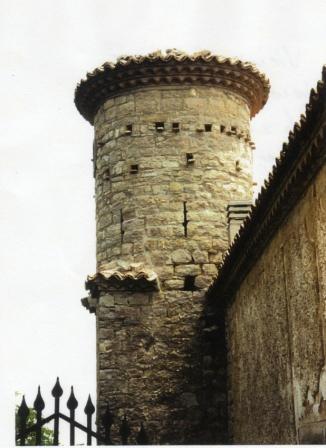
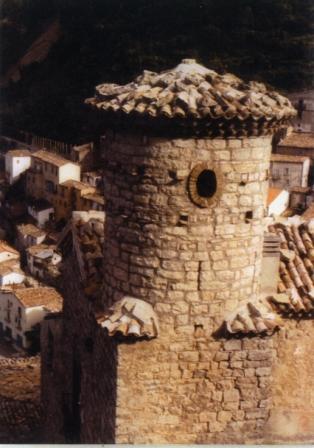
View of Tower incorporated
into Palazzo Frascella
Second view of Tower
former site of San Sabastiano's Bell Tower
Photo courtesy of Walter Librano
Photo
courtesy of Walter Librano
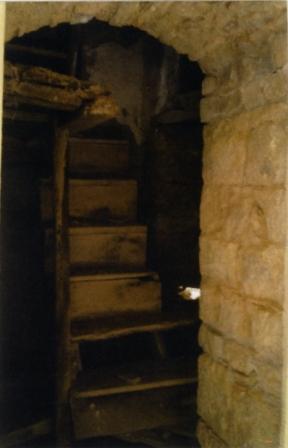
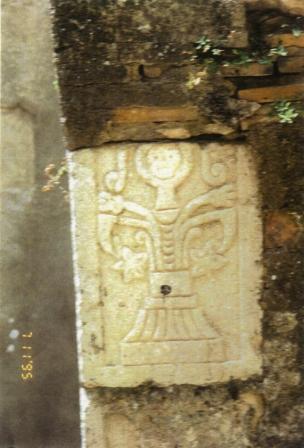
View of steps inside of tower of Palazzo Frascella
Ancient stonework incorporated into modern structure
Photo courtesy of Walter Librano
Photo courtesy of Dr. Daniel Frascella
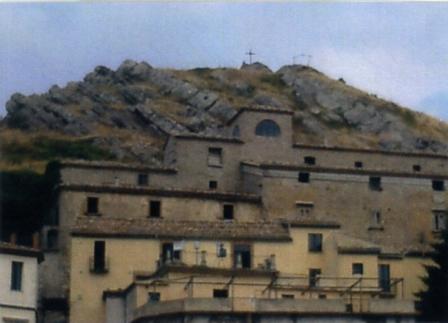
Monte Castello & Palazzo Frascella
Cleared area above Palazzo is site of Otto's Fortress.
Cross at top of mountain marks area as "Holy or consecrated ground".
In the late sixteenth
century a child was born in Genoa by the name of Girolamo
Grimaldi-Cavalleroni. A descendant of several of the most powerful
families in Genoa, he also traces his maternal line to San Fele as a
descendant of the baron of that town. In time Girolamo would realize
a religious vocation holding a number of important offices in the
Church and eventually being appointed a Cardinal Archbishop. He was
one of four Grimaldis to attain the rank of Cardinal of the Church.
© San Felese Society of New
Jersey
Contact Us
Home
|




